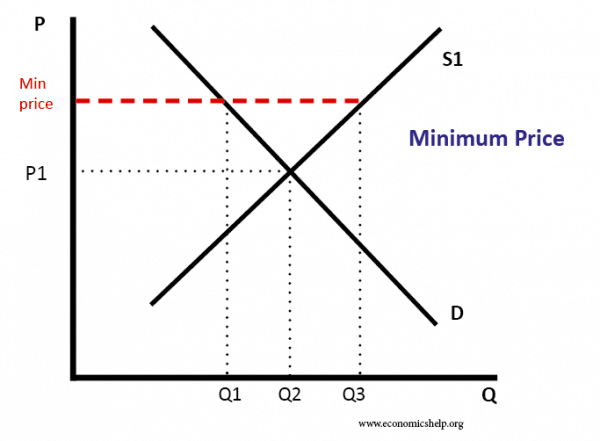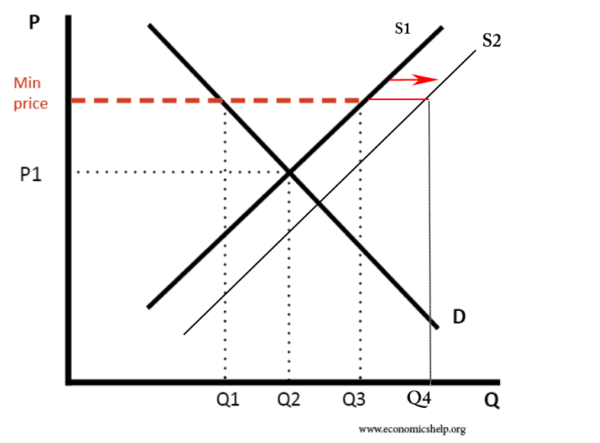Common Agricultural Policy (CAP) is EU’s policy on agricultural.
Stated Aims of CAP
- To Increase Productivity
- To Increase Farm’s incomes
- To Stabilize markets
- To assure the availability of supplies
- To ensure reasonable prices for consumers
- The most important is the second aim of increasing farm incomes
Why Subsidise Agriculture?
- The declining income of farmers. With increased income in the economy the proportion spent on agriculture is low. The YED of food is low. Therefore farmers lose out during economic growth.
- Positive Externalities of farming. If farmers go out of business, rural communities will suffer. This could also have consequences for the environment and tourism
- Fluctuating prices PED and PES for agricultural commodities are low therefore, prices can fluctuate significantly, causing problems for farmers and consumers.
Farmers subject to unpredictable shocks such as disease and bad weather
Price Support in the CAP
This CAP policy involves a system of “Target Prices” and “Variable Import levy”
CAP involves
- Import Tariffs on Cheap Imports
- Guaranteeing Minimum Prices for Farmers – Buying Surplus if necessary
What CAP intended to achieve
The main aim of CAP was to give farmers a target price for foodstuffs and ensure supplies. This minimum price would enable them to gain a certain level of income from products which often had low prices.
To maintain these target prices it was necessary to do two things:
- i) EU was to buy the surplus of food at the target price
- ii) A variable import tariff was imposed on cheap imports to make imports as expensive as the target price
The diagram illustrates how the CAP worked in practice
At the target price the Supply was much greater than demand therefore there was a surplus of Q2 – Q1 this is the amount that the EU had to buy. This is what led to the creation of stocks of food such as “butter mountains”.
The target prices actually encouraged farmers to supply more through intensive farming methods. Therefore the amount of surplus often increased in different years.
Costs of CAP
- Higher Prices encouraged extra supply, this resulted in a surplus of food. The EU had to buy this surplus. This is very inefficient and expensive. In 2000 CAP expenditure cost 36 billion Euros. In addition with the expansion of the EU, it is likely to increase the cost to the EU budget
- However the cost of CAP has reduced as a % of the EU budget from 66% to about 46% now (Extract D)
- To increase incomes of farmers consumers have had to pay higher prices. This is allocatively inefficient and also it increases inequality because low-income groups pay a higher % of their income on food
- CAP has caused economic difficulties for farmers in other countries. Firstly the excess supplies were dumped onto world markets. This caused prices to fall and lower revenues. Secondly, the EU bought less imports because of the variable import levy’s Therefore demand fell. The combined effect was to reduce farmers welfare in both the US and the developing world.
- Because of this, the CAP has been a major stumbling block to trade at the WTO. The US has retaliated against EU exports in response to the high degree of protection given to agriculture.
- However, the EU is not the only place where large subsidies to farming occur. Countries such as Japan and Korea have a high amount of subsidies given to farmers measured by Producer Subsidy Equivalents. PSE
- CAP has harmed the environment. CAP has encouraged farmers to increase output with the use of artificial fertilizers and pesticides causing problems for the environment.
- CAP has arguably not helped overcome poverty is some rural communities because subsidies have been directed to output rather than need. The fund primarily goes to large farmers and landowners. They have received more than they need but small farmers are still struggling e.g. hill farmers with a low number of sheep.
Benefits of CAP
- CAP has achieved some of its original objectives such as securing food supplies and stabilising markets.
- However, this could easily have been done with much less cost and distortion of the market.
- Recent reforms to CAP have improved its operation. Now funds can be given to land devoted to “nature conservancy, encourage organic farming and the establishment of young farmers. Therefore CAP is now beginning to direct funds in a more beneficial way.
- However these reforms arguably do not go far enough and there is still a lot of economic distortion within CAP which leads to the disadvantages mentioned in section 3:0
How CAP should be reformed
It would be very beneficial to abolish all target prices for all products. This would have several benefits
- It would lower prices for consumers
- It would help trade negotiations because the EU would no longer have to impose variable import levy and therefore farmers in other countries would be better off
- It would eliminate all food surpluses
- It would be less costly for the EU as they would not have to buy the food.
- It would reduce oversupply and therefore discourage intensive farming and therefore improve the environment
The main disadvantage of this is that farmers would have a fall in income. However, this can be overcome by more direct aid payments. In addition, these can be more targeted to farmers who really need them rather than paying landlords who are already well off. A ceiling could be imposed on payment to farmers.
One reason for subsidising farmers is that farming can have positive externalities therefore it makes sense for subsidies to be directed to these positive externalities. Therefore there could be an extension to aid for environmentally friendly measures such as organic farming.
A major advantage of these proposed reforms is that it should enable a reduction in the cost of CAP to the EU. Some farming pressure groups may be unhappy but there can be a clear gain to the EU because the money saved can be spent on more worthwhile projects such as subsidising depressed areas both rural and urban.
CAP is still 44% of the EU budget therefore this is a potentially very significant policy for the EU. It is especially important given the expansion of the EU into the east.
Related



Love the site. It provides vital information and adequate materials needed
Quite insightful.